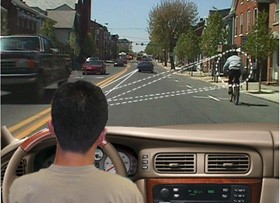

“It used to be thought that having 20/20 eyesight, and having healthy eyes, was sufficient to be visually prepared for success in this world. But what we know today is that the visual skills necessary for learning go far beyond the ability to see 20/20 and having healthy eyes.”
A paradigm shift from eyesight to vision has been in process for years and continues to be greatly needed. Eyesight is the ability to discriminate the differences between small things. Vision is the ability to derive meaning from the world, and to guide the intelligent movement of the body. The ability to discriminate the differences between small things (eyesight), occurs, when environmental details are captured from reflected or emitted light, through an imperfect optical matrix of biologically combined materials, and travel along the optic nerve traversing a single synaptic cleft, transporting the collimated light from the surrounding world, and are then sent to the occipital lobe, that most distal mass of cortex in the back of our skulls.
Twenty percent of these fibers leaving the eye, sneak off quickly along the fast acting magnocellular pathway, bee-lining it directly into the midbrain, not even considering entry into the thalamus. These neurons establish a liaison with regions of the cerebellum, the spinal tracts and the posterior parietal lobe, establishing a spatial construct inside of which cognition can safely reside. This spatial awareness arrives in advance of conscious awareness and thus allows for abstract cognitive thought and imagery to flourish without any obligation to act as a sentinel for spatial security.

The ability to derive meaning from the environment, and to guide the intelligent movement of the body (vision), begins where eyesight leaves off. The outpouring of nerves leaving the occipital lobe feed these visual details forward to all lobes and crevices of the brain, weaving the warp and weft of our human experience.
The ability, skill and endurance of the visual system to derive meaning from the world, depends upon a triad of muscular skills and panoply of perceptual and cognitive ones. The muscular abilities include accommodation, binocularity and tracking; tracking skills and are sub-divided into fixations, pursuits and saccades. These consciously driven muscular abilities are developed because of our interactions in the world. Once skillful “muscular” contact with the visual world is available, then visual perception develops; perception becoming the liaison between the illuminated world and our cognitive one.
Beyond determining the presence of clarity, eye-health, and muscular control in your patient (accommodation, binocularity, fixations, pursuits and saccades), a full evaluation of the visual skills necessary for full engagement in our increasingly demanding world, should also involve assessing visual perception and visual cognition. Unfortunately when these skills are assumed to be intact, or, when the testing of these abilities is overlooked, people and most commonly children, suffer from being misunderstood. Behavioral and physical symptoms are exhibited which may lead to treatments that are ineffective, or worse, inappropriate.
Visual dysfunctions often masquerade as behaviors such as ADHD/ADD and Dyslexia. Fortunately, these are diagnosis of exclusion, and until visual issues are ruled out, a diagnosis of these entities cannot be clinically established. Unfortunately, the siren song that 20/20 is perfect vision can lull the most disciplined clinician into thinking that all is well, when all is not.
When the critical muscular, perceptual and cognitive skills are not sufficiently developed, their development can be acquired through the careful application of a formalized vision therapy program, a program designed by Developmental Optometrists; optometrists trained in the diagnosis and treatment of the neurological, optical, perceptual and developmental foundations for cognitive development. The College Of Optometrists In Vision
Development certifies those optometrists specializing in this discipline. Their website (COVD.org) provides references for the scientific foundation from which their clinical work is derived, as well as referencing the contact information of doctors throughout the world who provide this specialized assessment and treatment. Children’s innate neurological malleability enables the treatment of their visual delays to be quicker and easier than adults; the assumption, though, that adults are too far beyond a critical period to be helped, is now often considered to be clinically naive. Not only is rigorous research into cognitive neuroscience revealing that an enormous amount of cortical plasticity exists in the adult human cortex, dramatic clinical breakthroughs have been made in heretofore-untreatable visual conditions such as adult strabismus (eyes out of alignment). Susan Barry, PhD, Professor of Biological Sciences and Neuroscience at Mount Holyoke College in Massachusetts – AKA “Stereo Sue” – had such a dramatic experience of visual awakening, she was compelled to write a book about her experience, an account so dramatic that world recognized neurologist and author, Oliver Sacks, MD, wrote the forward to her book; Fixing My Gaze- A Scientist’s Journey into Seeing in Three Dimensions. Dr. Barry not only describes her recovery, but the recovery of many other adults who have had the same opportunity to break into the third visual dimension of our world. Stereo Sue saw her first snowfall in 3-D, after treatment with optometric vision therapy at the age of 49 years old, an age far older than clinical success was thought to be possible. Her world literally expanded. She now enjoys the world as it is meant to be seen, in rich dimensionality; “a medium on which tree branches, flower blossoms, and pine needles floated.” Surgery was performed twice as a child, without success. What would her life have been like if, as a little girl, she could have had vision therapy, and had the opportunity to see the world then, as it is now?
Vision develops as we engage in the world. Again, I am not referring just to 6/6 eyesight. Vision, as described earlier, can be developed in those of any age, who have not experienced its wonderful gift. The behavioral challenge of not understanding the visual world is devastating; the ability of being able to understanding the visual world is a gift.